When Charlemagne Palestine was fifteen, the legendary composer Igor Stravinsky said he could stay. So he stayed, and created a crazy, noisy, colourful, and honest universe that knows no borders, labels, trends, or rules of spelling. The Brussels-based New Yorker is now transforming the majestic Bozar into the amusement park CharleWorld for his first Belgian “sschmmettrroossppecctivve”. “What’s that? Good, that’s exactly what it is!”
© Heleen Rodiers
Who is Charlemagne Palestine?
- •was born the son of Jewish immigrants in New York in 1947
- sang traditional Jewish cantor music in the synagogue as a six-year-old
- accompanied beat poet Allen Ginsberg and Tiny Tim on an exotic hand drum in Greenwich Village
- at sixteen, he became the carillonneur of Saint Thomas Church, earning him the nickname “the Quasimodo of New York City”
- developed his rainbow continuum of sounds in Morton Subotnick’s Electronic Music Studio
- studied and taught at the California Institute of the Arts and became a performance artist
- was appropriated as a champion of minimal music
- started developing the visual side of his performances and exhibited at Documenta and the Venice Biennale
- moved to Brussels in the late 1990s and married Aude Stoclet
CharleWorld. Amusement park, studio, and sanctuary all rolled into one. And home to its creator, Charlemagne Palestine. The 70-year-old Brooklyn-born avant-garde artist, who has lived in Brussels for almost twenty years, has just taken delivery of a few containers of cuddly toys from Los Angeles at this enormous warehouse in Evere, which is bursting with stuffed animals, colourful rags, and bells, and is getting ready for his “sschmmettrroossppecctivve” at Bozar, his…uh… “I don’t like the word retrospective,” Charlemagne Palestine explains. “It’s so scary and can be final, so I Yiddishified it and turned it into ‘Aa Sschmmettrroossppecctivve’. Everybody asks me: ‘What’s that?’ And that’s good, that’s exactly what it is! Better that you don’t know what it is than that you think it’s sort of near the end.” [Laughs]
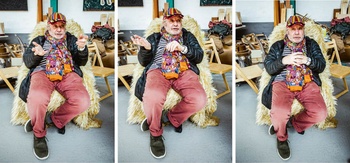
© Heleen Rodiers
This elusiveness has characterized Charlemagne Palestine for his entire life. It is a life that has taken him from the carillon of Saint Thomas Church in Manhattan to the beatnik scene in Greenwich Village, the minimalist music scene, the foundation of the California Institute of the Arts, video and body art, the Venice Biennale, Documenta in Kassel, the Centre Pompidou…and the Horta Hall at Bozar, where he celebrated Karel Geirlandt’s appointment as the director of the Centre of Fine Arts in 1974 with a performance on an Imperial Bösendorfer, the biggest most resonant piano of that time, surrounded by his cuddly toys.
“That was my first time in Brussels,” Charlemagne Palestine says. “Karel Geirlandt and Hergé [creator of Tintin and a fervent collector of American avant-garde art – KS] came to my studio in Soho to invite me to the event. Afterwards I became a regular here. Fanny [Vlamynck, Hergé’s wife – KS] already had a funny feeling. She used to read the Ouija board, and she often implied that this could actually be my home. And now it is. Who would have imagined? But I’m happy that this is where I ended up, in my own CharleWorld, surrounded by my bells and animal divinities from my childhood, and a place which is kind of like either a synagogue or a church or a temple, my studio. I was finally able to do what I dreamed of, what I responded to. I am lucky to have that now at 70 years old.”
I believe in the idea that these beings, these stuffed animals, can be divinities. If they are permitted, they will live long after we have gone
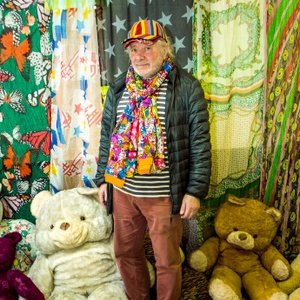
Bells and gongs
Let’s rewind 55 years. Charlemagne Palestine is 15 and sneaks into a rehearsal of the Columbia Symphony Orchestra conducted by Igor Stravinsky thanks to his then girlfriend’s father. The young Charlemagne is sitting there eavesdropping, behind a sort of dressing screen. When the eccentric Stravinsky noticed the screen, he shouted: “What’s that doing there?” The screen was pulled away and there he sat. Stravinsky looks at him and asks: “Who are you? What are you doing here?” “I don’t know,” the young man answered. After a long pause the conductor says: “You can stay!” So he stayed.
This anecdote illustrates the openness of the age in which Charlemagne Palestine, the son of Jewish immigrants from Minsk and Odessa, grew up. “I developed in one of the most fertile art melting pots in the world, a very cosmopolitan and open city. I came from a very boring and a very poor, underdeveloped sort of society. But my mother loved culture, in whatever way. And she was very permissive, she never wanted me to be a doctor or a lawyer. No one really had any expectations of what I would do. So I have been able to invent my life.”
“And it was New York City, where there was and still is an enormous intellectual climate. So when I went to high school, I met people whose parents were great writers, poets, painters, Pulitzer prize winners, an enormous number of great artists.” The High School of Music & Art in Manhattan was started by Fiorello LaGuardia in the 1930s. “He was an immigrant, half Catholic, half Jewish Italian, who started five different high schools for immigrant children, because he wanted them – if they were exceptionally talented – to have an exceptional education. And people saw something in me.”
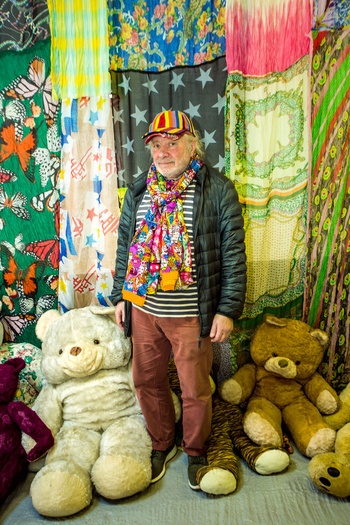
© Heleen Rodiers
When you were six you were already singing traditional Jewish cantor music in the synagogue. And when you were fifteen you were already playing carillon?
CHARLEMAGNE PALESTINE: I was into bells, and it was a job that nobody wanted. [Laughs] Saint Thomas Church was right next to the Museum of Modern Art, you could hear the music in the sculpture garden. They were looking for someone to take on the tradition. So I played every day for about six and a half years [earning him the nickname “the Quasimodo of New York City” – KS]. The church – even now a very uptight Protestant Episcopal church – wasn’t very happy with me, they wanted me to play hymns and just accompany the religious stuff on Sunday morning. But there were other companies, like Columbia Pictures and Records and the MoMA itself, that all found it interesting to have a radical young avant-garde composer playing on the street. So at fifteen, I started to invent music, because I was listening to Javanese, Balinese, Japanese, and Tibetan music that all used a lot of bells and gongs. That’s how I came to use church bells in a unique way.
How did you come into contact with all those influences?
PALESTINE: Back in those days, there was a very important record company, Folkways Records, owned by a guy called Moses Asch. He was obsessed with the different kinds of music that had been found by anthropologist and ethno-sociologists and so on. So you could hear music from Java, Bali, the Aboriginals, the Pygmies… And then there was the public library and the record library of Manhattan. They had all the early music by people like Stockhausen and Xenakis, Berio, Messiaen… As a younger developing artist I was exposed to all these different influences, and at the same time, as I eventually became what I now like to call a “Gesamtkünstler”, I merged all these different things: visual, sound, the body.
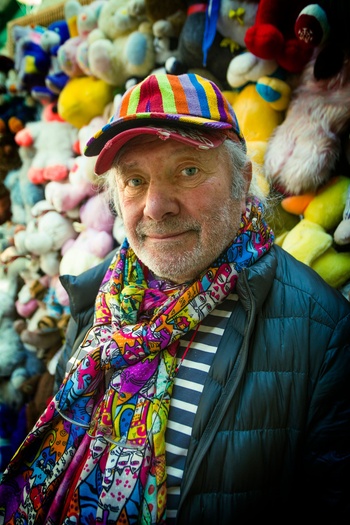
© Heleen Rodiers
| Charlemagne Palestine in front of one of his stuffed animal installations
To the max
The artist, who was so boundlessly curious and infinitely inspired, and consequently developed an abhorrence for any and all boundaries, started stretching and expanding possibilities, not only in his intimate yet impressive sound pieces, which he started couching in a mise en scène in which his beloved stuffed animals were to evoke a whole universe, but also by exploring his body and voice in performances by running, chanting, falling, and ranting.
This gesamt soul bears wounds inflicted by the guardians of boundaries. “They always cut me in pieces. I was always either a musician or a performer or a video artist or a plastician. It was hard to be all of them in the climate of the 1950s, ’60s, ’70s, or even ’80s. When people like Mike Kelley and Jeff Koons, who were younger than me, started using toys in their language, they weren’t already tagged as pianists. So the system immediately labelled me as their disciple because in the system’s view I was a pianist. Now with young people, every young artist is a kind of Gesamtkünstler. That resistance I experienced from my own generation – because nobody could figure out what the fuck I was doing – is gone. Now basically everybody gets it. It has become a language now.”
You are often described as part of the minimalist music scene, together with people like Steve Reich and Philip Glass, but you have always resisted that term.
PALESTINE: I mean, minimalism? In a world that is so open and free, so full of noise, and hustle and bustle, and globality? Even if you want to do something that’s sort of reduced, I would try to find a sexier word. Maximalism, that’s a little sexier. Let’s do things to the max! You want to do things to the min? [Laughs]
Minimalism is a term that should have lasted a week. Phil and I used to share a space, for two years, 45 years ago. I have always been the more unpredictable and crazy one of the two of us. He’s also older than me. But lately he has also started denouncing the term minimalism. It took him until he was 80, but he resists it now too. And I’m not sure that Steve would like it now either.
It is like trying to cover yourself up in a cocoon, all foetal and comfortable, because the world is too much. Somehow it makes people’s lives feel more orderly, I suppose. But for me, it always felt like a prison term. In its most rigid, didactic, and inflexible form, that kind of repetitive rhythm, I not only disagree with, but it makes me terribly physically uncomfortable.
For your 1974 sound piece Strumming you played two notes in rapid alternation, with music swelling to a trancy cloud. It’s an almost spiritual experience.
PALESTINE: I use the word “sacred” rather than “spiritual”. It’s a word that has always resonated with me, because it’s a certain place, it’s a certain feeling, and yet it’s nothing specifically, no specific religion, philosophy, or point of view. This place is like a sacred bordello.
Growing pains
It is that sacred bordello that we are expecting at Bozar, where Charlemagne Palestine is installing huge altars, totems, and shrines with stuffed animals in all sizes and colourful rags. Intense euphoria goes hand in hand with a sacral atmosphere, a hopeful smile with a heart-wrenching sense of loss. There is a profound pain in the exuberant, colourful heart that beats in these bodies. A pain that is both intimate and comes from a deeply human connection. “All my work comes to me, not as ideas or concepts, but intuitively…” Charlemagne Palestine explains. “I often wake up in the middle of the night, feeling pains or terrors. And so I respond to those, and I come up with my puzzle. It’s the intuition of my body suspecting what could happen, would happen, should happen. I just sort of branch out and whatever happens, happens…”
Like when your mother wanted to throw out your own stuffed animals?
PALESTINE: True, that’s an amazing story. I was ten or eleven and she thought I was old enough to get rid of them and asked my father to throw them away. He kept them in the trunk of our car for a while because they spoke to him. I was shocked. I used those animals to speak for me when I was a child. But I didn’t realize that my father, who was very introverted, was so influenced by my tendencies. I only really knew after he died. You don’t always know what’s going on in those realms of other people.
Your stuffed animals already accompanied you on stage during performances. What made you want to develop a form around them?
PALESTINE: In the beginning, they were just fetish objects. I didn’t see them beyond that. But there was one bear that I got from a woman I was with around 1969-1970. In the late 1970s, when things were getting very bad for performance artists in my kind of position, I wanted to go more and more into plastic art. And he was the one who said, in a kind of dream: “Well, why don’t you have us be part of your language?” That’s when it started to really work for me. Later on, I found out that the teddy bear was actually born five kilometres from where I was born, when Rose and Morris Michtom, two Russian Jewish immigrants who lived in Brooklyn, invented him in 1902.
Sometimes people say that they are really only for children. Then I say: “These are for children of all ages, from 1 to 116.” I believe in the idea that these beings can be divinities, like Ganesh, the Hindu god, half elephant, half man, who is the primary inspiration of my work.
In Los Angeles, I found 18,000 stuffed animals that no one knew what to do with. They were no longer clean or fresh. Things go in and out of style in the stuffed animal world too. They are like refugees. Like my family, who came over in a boat. They tore up their papers before they came to America, so nobody would know where to send them back to. So they are part of the same story, but at the same time, if these beings are permitted, they will live long after we have gone. I imagine that they’re listening or something is entering their animist consciousness, and they will live for centuries.
“I’ve been lucky in that my work has never been that successful,” Charlemagne Palestine murmurs. “When people want to buy my divinities, I always give them a nice high price and they decline. These creatures are so much a part of me, that it’s sort of like the farmer who names his animals and in the end can’t bring himself to kill them. I can’t say that all of my animals have names, but many of them do. I fall in love with every new work I make. Every time they come back from a show, I’m so pleased. And now I’m starting a foundation here in Brussels. The Charlemagne Palestine Foundation will have all my favourite pieces. Who would have thought? Fanny was right all along!”
> AA SSCHMMETTRROOSSPPECCTIVVE. 18/5 > 26/8, Bozar
> Vitrine: Charlemagne Palestine. 18/5 > 18/6 (18/5, 20.00: opening & performance with Sigtryggur Berg Sigmarsson), NICC
> Charlemagne Palestine: Newwwsswirlll. 25/5, 22.00, Kanal – Centre Pompidou
Read more about: Expo , Muziek , Bozar , Kunstenfestivaldesarts
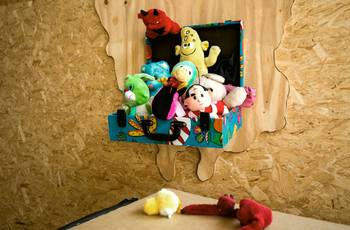
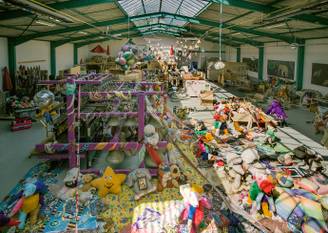
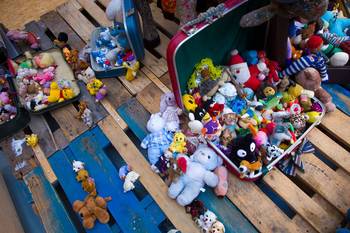
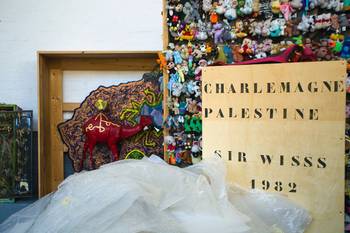

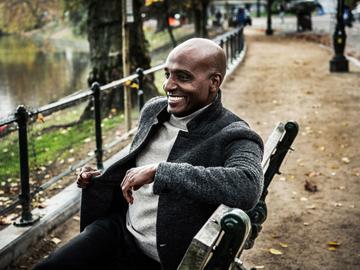


Fijn dat je wil reageren. Wie reageert, gaat akkoord met onze huisregels. Hoe reageren via Disqus? Een woordje uitleg.